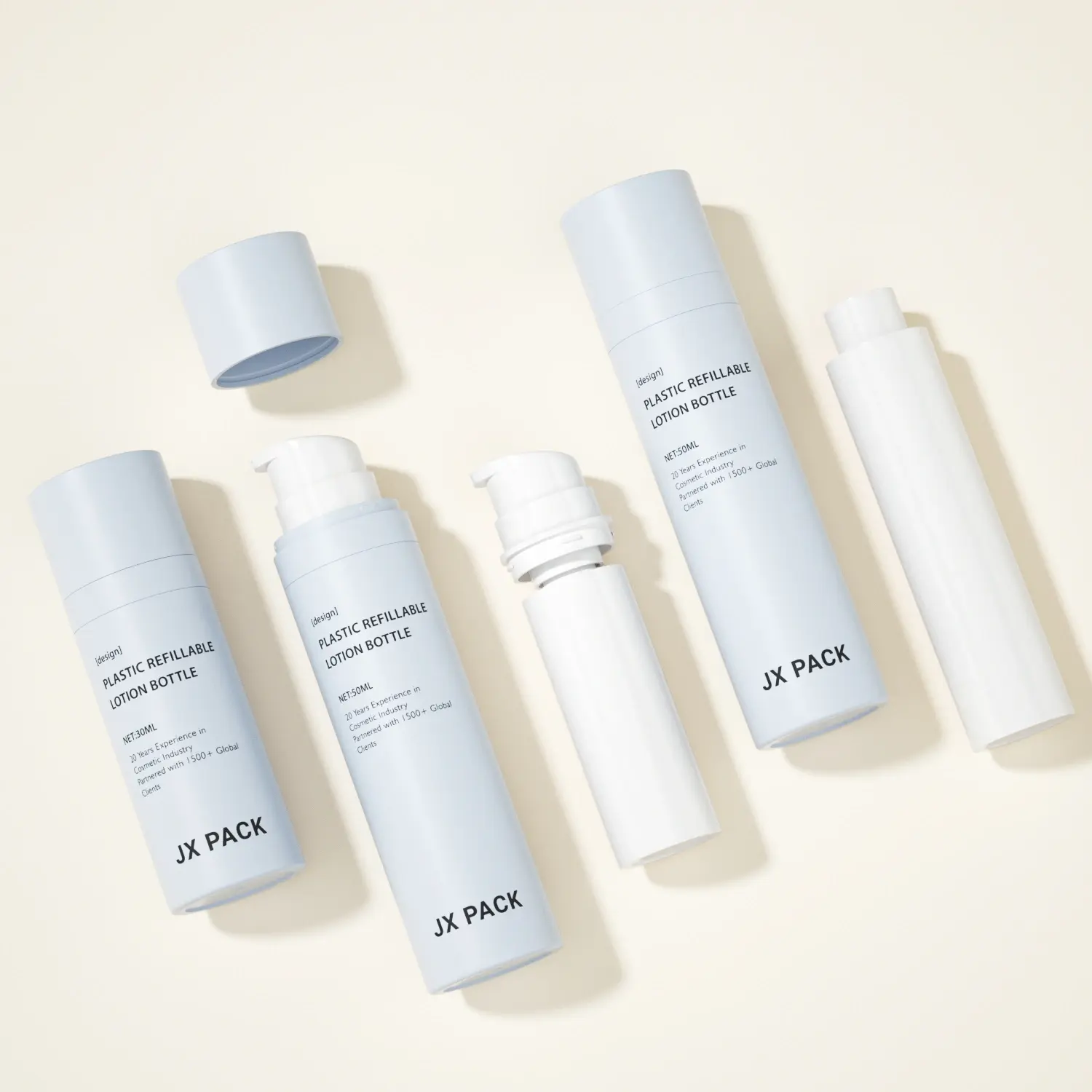In an industry that produces a staggering 120 billion units of packaging annually, the beauty sector is experiencing a transformative shift toward sustainability. Refillable cosmetics have emerged not as a passing trend but as a necessary evolution for brands seeking to remain competitive and environmentally responsible. As of May 2025, this shift is accelerating, with the refillable beauty cosmetics market experiencing unprecedented growth and projected to continue expanding in the coming years.
This comprehensive exploration delves into the world of refillable cosmetics, examining current market trends, innovative approaches, challenges, and strategic implementation for cosmetic skincare businesses looking to embrace this sustainable revolution.
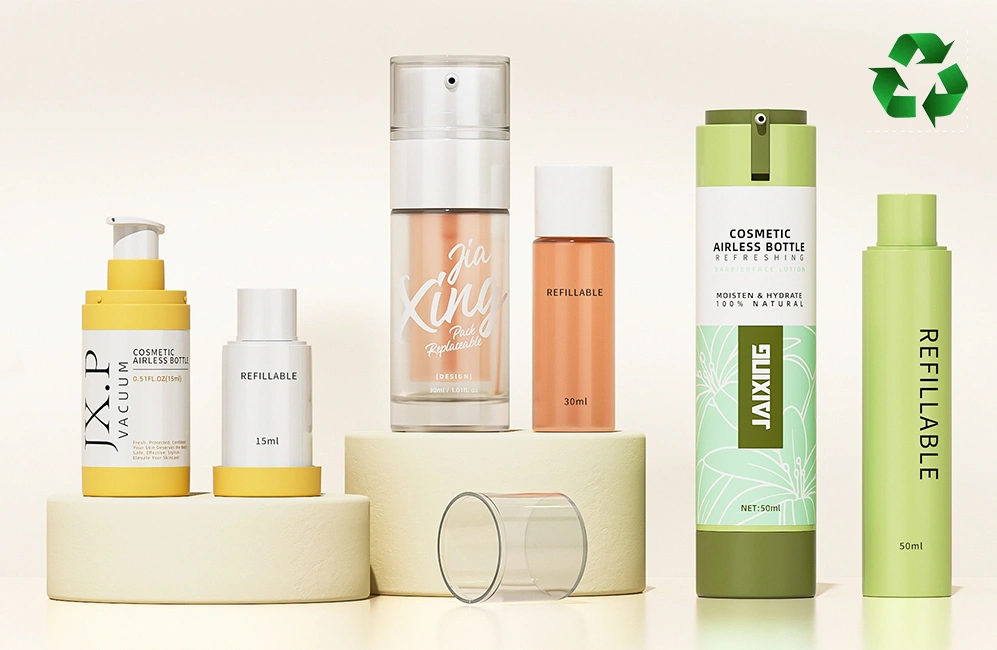
1.The Current State of Refillable Cosmetics
The beauty industry has witnessed remarkable growth in refillable options across various product categories. What was once a niche offering has rapidly expanded into mainstream consciousness, driven by increasing consumer awareness and demand for sustainable alternatives.
Market Growth and Consumer Demand
The refillable beauty market has experienced explosive growth in recent years. According to NPD Group data, makeup saw the strongest category growth with sales of refillable products increasing by an astonishing 364% from January through July 2022. This growth trajectory has continued, with the refillable beauty cosmetics market estimated to be in the range of $500 million to $1 billion USD in 2025.
The broader refillable packaging market is projected to reach USD 62.60 billion by 2030, growing at a CAGR of 5.7% from 2025 to 2030. Within specific segments, the refillable deodorants market alone was valued at USD 3.1 billion in 2025 and is predicted to grow by a CAGR of 11.6% from 2025 to 2035, reaching USD 9.3 billion by 2035.
Consumer preferences are clearly shifting toward sustainability. Sales of refillable prestige beauty products in the UK increased 47% from January to the end of July 2022, with the market valued at £34M in this seven-month period. These products outperformed the total prestige beauty market, which increased 22% during the same timeframe.
The refillable beauty cosmetics market is experiencing significant expansion driven by several factors:
- Increasing consumer awareness of environmental sustainability
More people are paying attention to how their choices affect the planet. In beauty, this means looking for products that create less waste and use eco-friendly materials. Refillable packaging helps reduce the impact, making it an attractive option for environmentally conscious shoppers. - Growing preference for reusable packaging
Consumers are moving away from single-use packaging and choosing products they can reuse. Refillable containers feel more premium, last longer, and are better for the environment—making them a smart and sustainable choice. - Rising popularity of minimalist and zero-waste lifestyles
Many people are simplifying their routines and trying to produce less waste. Refillable beauty products fit perfectly into this lifestyle, offering a clean, low-waste solution without sacrificing quality or style. - Proactive brand efforts to incorporate sustainable practices
Beauty brands are stepping up, offering refillable packaging and reducing waste as part of their sustainability goals. These efforts show customers they care about the environment while keeping up with modern values and trends.
Governments and regulatory bodies are also contributing to this market shift. For example, the European Union’s Green Deal and Extended Producer Responsibility (EPR) regulations are pushing brands to adopt more sustainable, reusable packaging systems. These evolving policies are making refillable formats not just a consumer-driven trend, but a compliance requirement in many regions.
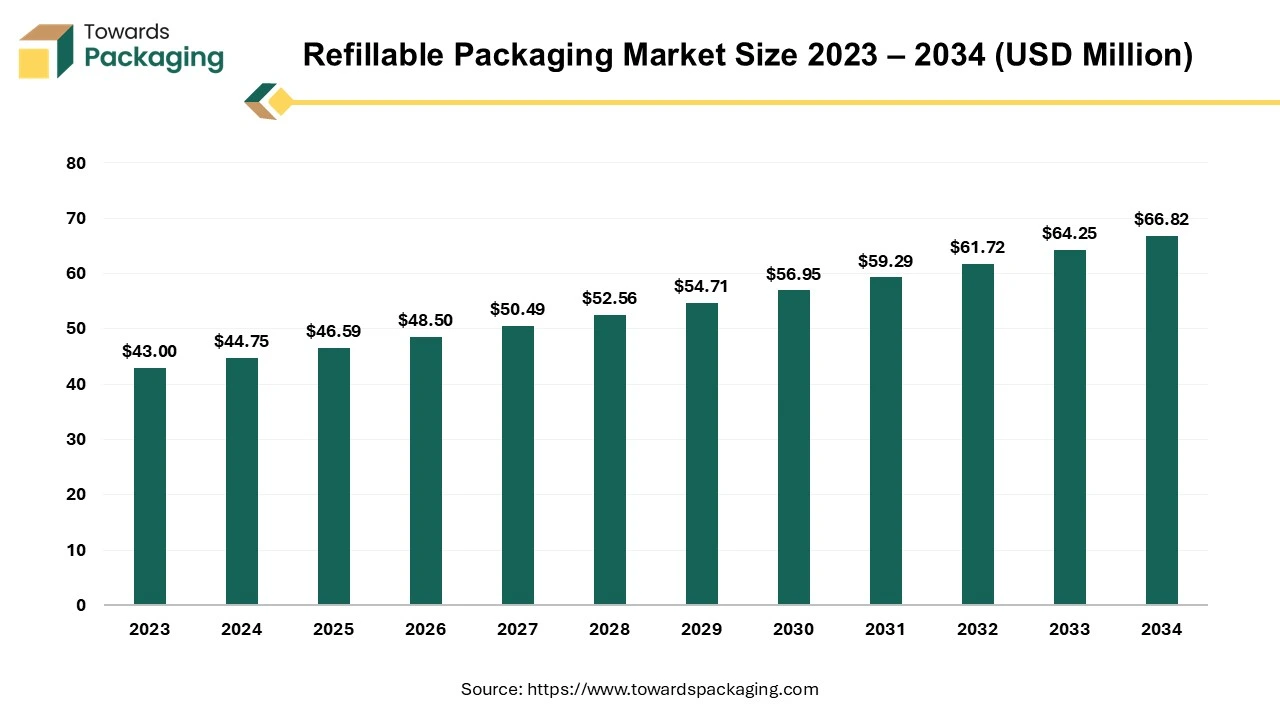
2. Benefits of Refillable Packaging Systems
The advantages of implementing refillable packaging extend beyond environmental considerations to include economic benefits for both consumers and brands, as well as enhanced consumer experiences.
Environmental Impact
The environmental benefits of refillable systems are substantial and multifaceted:
- Significant waste reduction: Refillable systems dramatically cut down on the amount of packaging waste entering landfills
- Lower carbon footprint: Refillable packaging typically contains less plastic than regular single-use bottles
- Resource conservation: Brands can reduce emissions through refill pouches that use less plastic than regular bottles
- Circular economy contribution: Refillable containers allow for continual reuse, meaning fewer resources are consumed over time
Economic Advantages
The economic benefits of refillable systems create a win-win scenario for both consumers and brands:
- Consumer cost savings: Refills are often priced lower than purchasing a complete new product, as companies save on packaging costs and pass these savings to consumers. Research indicates that price is the most influential factor (92.7%) in purchasing refillable packaging products
- Brand loyalty enhancement: Consumers appreciate brands that demonstrate environmental consciousness, leading to increased customer retention and a positive brand image
- Premium positioning opportunities: Brands leverage high-quality, durable containers as luxury items in themselves, justifying premium pricing while encouraging refill purchases
- Reduced packaging costs: Over time, brands can reduce their packaging material expenses as consumers reuse their original containers
Consumer Experience Benefits
Refillable systems can significantly enhance the consumer experience:
- Customization opportunities: Many refillable systems allow consumers to mix and match products, choose different colors, and select the quantity they need
- Convenience for travel: Refillable systems are often designed with portability in mind, making them ideal for travel without sacrificing quality
- Luxury experience: Many refillable options feature high-quality, durable packaging that elevates the user experience
- Alignment with values: Consumers feel good about purchases that align with their environmental values, creating an emotional connection to brands that offer refillable options
ESG and Brand Storytelling:
Refillable systems also serve as powerful storytelling tools in ESG (Environmental, Social, and Governance) reporting. Brands leveraging refill initiatives often gain favor with environmentally conscious investors and can differentiate their brand story through transparent impact metrics, aligning product design with corporate sustainability commitments.
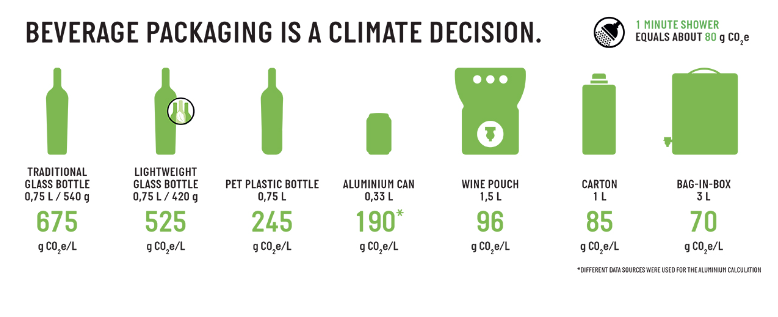
3. Challenges in Implementing Refillable Systems
Despite the clear benefits, implementing refillable systems presents several challenges that brands must navigate carefully.
Product Formulation and Safety Concerns
Refillable beauty systems offer sustainability benefits, but they also come with important safety challenges that must be addressed to protect product integrity and consumer health:
- Contamination prevention
Refillable packaging must be designed to avoid contamination during the refill process and with repeated use. Clean dispensing systems and airtight closures are essential to keep the product safe.
- Preservative systems
Formulas may need to be adjusted to stay stable and effective, especially as containers are opened and refilled over time. Strong and well-balanced preservative systems help prevent spoilage or microbial growth.
- Product compatibility
Not all cosmetics are a good fit for refillable packaging. Skincare products, especially those with active ingredients or water-based formulas, are more sensitive than alcohol-based products like perfumes, which are naturally more resistant to contamination.
- Shelf-life considerations
Products must stay safe and effective through several refill cycles. Brands need to test and confirm that the product’s shelf life holds up even after repeated handling and exposure to air.
Design and Functionality Hurdles
Designing refillable packaging that consumers love involves overcoming several practical and aesthetic challenges:
- User-friendly mechanisms
Refill systems need to be simple and intuitive. If they’re too complicated or messy, consumers may avoid using them.
- Aesthetic considerations
Refillable packaging still has to look good. Brands must find ways to keep the design stylish and premium, even with added refill features.
- Durability requirements
Reusable containers must be strong enough to handle repeated use without cracking, leaking, or wearing down over time.
- Product protection
It’s crucial to keep formulas safe. Packaging must have airtight seals or protective barriers to preserve the quality of sensitive products.
Supply Chain and Logistics Considerations
Transitioning to refillable systems involves several logistical challenges that require careful planning and adaptation across the supply chain.
- Manufacturing Adaptation: Existing production lines often need to be reconfigured or upgraded to handle refillable components. This may include changes in assembly processes, quality control measures, and material handling to ensure that refillable packaging meets durability and safety standards.
- Distribution Complexities: Shipping refill products safely demands innovative packaging solutions that protect the product during transit while minimizing waste. Unlike traditional single-use packaging, refill units often require specialized containers or cushioning to prevent leaks or damage, which can affect shipping costs and logistics strategies.
- Retail Implementation: Installing in-store refill stations introduces new spatial and operational challenges. These machines tend to be bulky, requiring dedicated retail space and proper setup. Additionally, retailers must manage dual inventory systems — one for the initial product purchase and another for the refill units, complicating stock management and customer service workflows.
- Traceability Concerns: Refillable systems increase the importance of robust traceability. In case of contamination or product recalls, brands must be able to track every batch and its distribution path quickly and accurately. This calls for enhanced labeling, tracking technologies, and data management systems to maintain consumer safety and regulatory compliance.
Cleaning and End-of-Life Logistics:
One challenge often overlooked is how consumers clean and maintain refillable packaging. Improper cleaning can lead to contamination or degraded product quality. As a response, some brands are implementing collection or return-for-refill programs, allowing consumers to send back used containers for safe industrial cleaning and reuse.
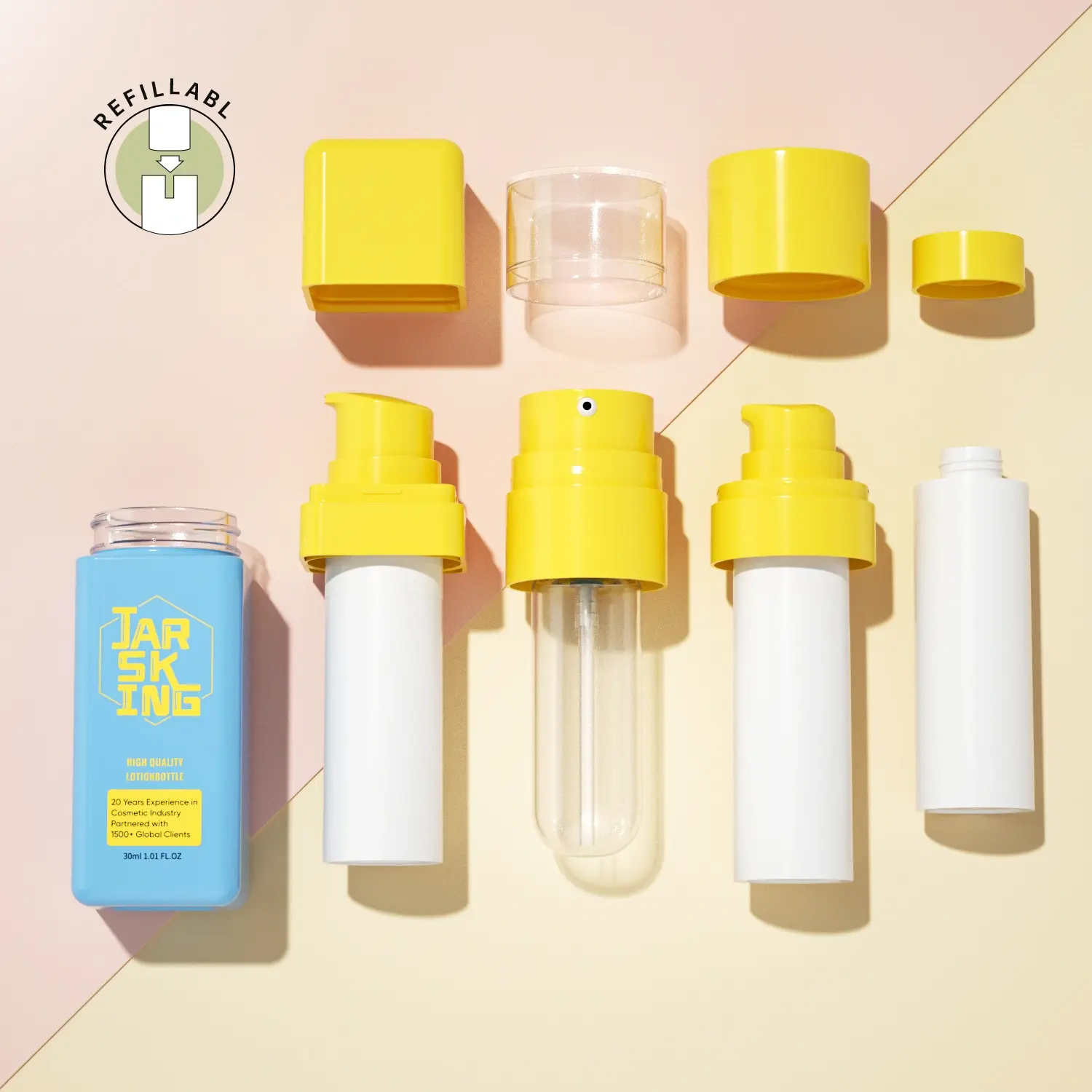
4. Innovative Approaches to Refillable Packaging
Despite these challenges, brands are finding creative solutions through material innovation, clever design, and technology integration.
Material Innovations
Sustainable materials are driving the evolution of refillable packaging, offering eco-friendly alternatives without compromising quality or aesthetics.
- Glass Containers: Valued for their recyclability and premium feel, glass containers remain a favorite among brands aiming for an elegant, sustainable packaging solution that consumers trust and cherish.
- Biodegradable Plastics: Derived from renewable plant-based sources like sugarcane or corn starch, biodegradable plastics present a greener alternative to conventional plastics, breaking down naturally and reducing environmental impact.
- Recycled Aluminum: Combining durability with sustainability, recycled aluminum offers infinite recyclability while maintaining a sleek, modern appearance — ideal for brands focused on longevity and environmental responsibility.
- Post-Consumer Recycled (PCR) Plastics: Increasingly popular, PCR plastics incorporate materials recovered from consumer waste streams, significantly reducing reliance on virgin plastics and helping brands lower their carbon footprint.
Clever Design Solutions
Innovative design strategies are enhancing the practicality and attractiveness of refillable systems, making sustainability both functional and stylish.
- Detachable Pump Systems: These clever mechanisms allow the pump, which is integrated into the external shell, to be easily detached and reused when the refill is replaced. This not only reduces waste but also improves user convenience.
- Durable PP/PE Materials: Polypropylene (PP) and polyethylene (PE) are increasingly used to create sturdy, reusable packaging components that withstand repeated use while maintaining product integrity.
- Stand-Up Pouches with Caps: Research shows that standard stand-up pouches and stand-up pouches with caps—both crafted from monomaterials—are highly recyclable and well-received by consumers. Their flexible form factor offers convenience without compromising sustainability.
- Box Pouch Packaging: Featuring a square bottom and side gusset, box pouches offer a distinct alternative to traditional stand-up pouches. While currently more common in the food industry, this format holds potential for cosmetic packaging innovation due to its stability and shelf presence.
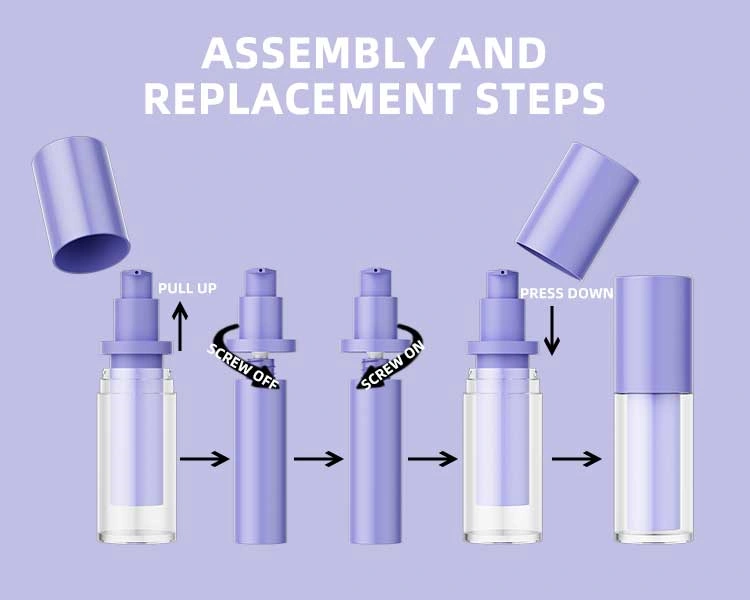
5. Brand Examples of Refillable Packaging
L’Occitane en Provence–A Pioneer in Refillable Beauty Packaging
L’Occitane en Provence has emerged as a global pioneer in sustainable beauty through its eco-refill system, a forward-thinking packaging innovation that dramatically reduces environmental impact while preserving the brand’s luxurious identity. Introduced over a decade ago and steadily expanded, the eco-refill system allows customers to replenish their favorite products—such as shower gels, shampoos, conditioners, liquid soaps, and hand washes—without purchasing a new bottle each time. Instead, consumers refill their existing containers using lightweight pouches made from monomaterial plastic films, which are more easily recyclable and use up to 90% less plastic than traditional rigid bottles.
Design & Materials Innovation
The eco-refill pouches are engineered for circularity: they use monomaterials (often polyethylene), which are far easier to recycle in existing systems compared to multilayer flexible packaging. Some versions also include a percentage of post-consumer recycled (PCR) content, further reducing virgin plastic dependency. The pouches are designed with a spout and cap for easy pouring, minimizing product waste during refills. L’Occitane has partnered with packaging suppliers to ensure these pouches meet both durability standards and environmental requirements.
Distribution & Refill Infrastructure
L’Occitane’s eco-refill strategy is not confined to online orders—it is deeply embedded into the in-store experience. Select flagship boutiques now feature refill fountains, sleek installations that allow customers to refill bottles on-site with favorite products. These refill stations are especially prevalent in key markets like France, the UK, and Hong Kong, and are gradually expanding worldwide. Online, customers can easily order refills and receive guidance on reusing their original containers.
This multi-channel approach makes refills accessible, convenient, and engaging, reinforcing sustainable behavior across different consumer touchpoints.
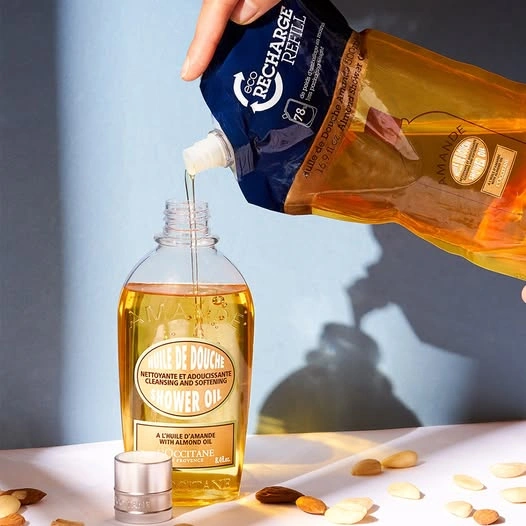
Consumer Engagement & Loyalty
To boost adoption, L’Occitane has paired its refill strategy with a clear sustainability narrative and tangible consumer benefits. Refill pouches are priced lower than regular products, offering cost savings alongside environmental advantages. The brand also integrates eco-refills into its loyalty program, rewarding repeat purchases and incentivizing sustainable habits.
L’Occitane has also embraced transparency and education, using in-store signage, website content, and social media campaigns to explain the environmental impact of plastic reduction and promote the benefits of refilling. This is especially resonant with millennial and Gen Z consumers, who are highly motivated by environmental values and conscious consumption.
Environmental Impact & Corporate Goals
This program directly supports L’Occitane’s ambitious sustainability roadmap, which includes achieving 100% eco-designed packaging by 2025. That means all packaging will either be refillable, reusable, recyclable, or made with recycled content. In 2023 alone, L’Occitane reported saving over 200 tons of plastic through its refill initiatives.
The company also participates in broader circular economy efforts, such as its partnership with TerraCycle in various regions, enabling hard-to-recycle packaging to be collected and reused or recycled responsibly.
Strategic Value & Industry Leadership
By successfully merging luxury and sustainability, L’Occitane has proven that refill systems are not limited to niche green brands—they can thrive within a global premium business model. The eco-refill system has helped the brand boost repeat purchases, enhance brand loyalty, and differentiate itself in a crowded beauty market.
This scalable, consumer-friendly refill strategy has positioned L’Occitane as a role model for sustainable innovation in the cosmetics industry. As more beauty brands seek to lower their environmental footprint, L’Occitane’s refillable approach offers a compelling template that blends practical design, environmental stewardship, and strong brand alignment.

Market Analysis: Current Trends and Distribution Channels
The refillable cosmetics market continues to evolve, with several key trends shaping its current state and future direction.
Distribution Channel Dynamics
- Online sales segment: Projected to dominate the refillable beauty cosmetics market through 2033, driven by convenience, wider product selection, effective targeted marketing, growth of direct-to-consumer models, and the influence of social media
- Offline segment: Currently holds a significant market share as these stores offer a wide range of products under one roof, along with promotional schemes and discounts to increase store footfall
- In addition to online and offline retail, professional skincare and beauty channels—such as spas, dermatology clinics, and salons—present growing opportunities for refillable packaging. These environments allow for direct education, controlled product dispensing, and recurring customer engagement through refill systems.
Product Category Performance
Refillable packaging adoption varies widely across product categories, reflecting distinct consumer behaviors and market dynamics.
- Fragrance: At the forefront of refillable innovation, the fragrance sector leads prestige beauty markets, with approximately 5% of total fragrance sales volume now coming from refillable packaging. This shift highlights growing consumer interest in luxury products that combine elegance with sustainability.
- Makeup: Makeup shows the strongest growth in refillable formats. Over half of makeup refill sales come from lip color products, followed by bronzers and blushes. This trend underscores consumers’ desire for convenient, eco-friendly options in everyday beauty essentials.
- Deodorants: Refillable deodorants have become emblematic of the zero-waste movement, cultivating a dedicated consumer base committed to sustainable living. This category continues to gain traction as awareness around environmental impact rises.
- Personal Care Items: Lotions, shampoos, and conditioners also hold significant shares in the refillable market. These everyday personal care staples are increasingly offered in refillable packaging, reflecting a broadening acceptance of sustainable alternatives.
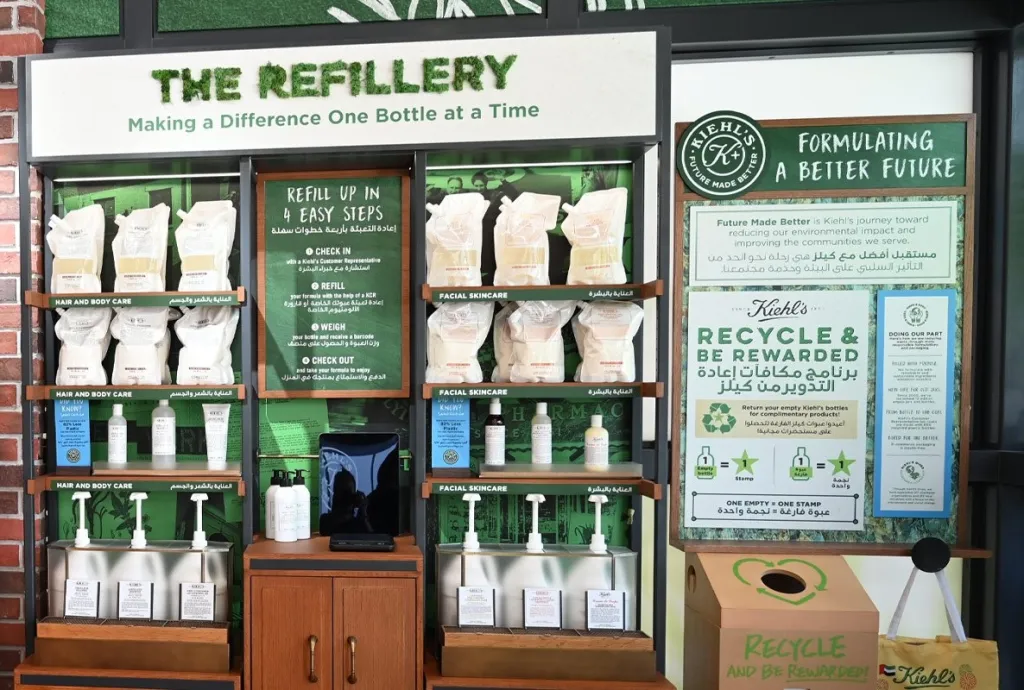
Regional Market Insights
Adoption and growth of refillable packaging vary significantly across regions, presenting diverse opportunities shaped by local consumer behaviors and market conditions.
- North America and Western Europe: These regions currently lead the market, buoyed by high consumer awareness of sustainability and strong disposable incomes. Established infrastructure and supportive regulatory environments further accelerate the adoption of refillable systems.
- Asia-Pacific: Representing a fast-growing market, Asia-Pacific is driven by expanding middle-class incomes and a rapid rise in online shopping. This region offers considerable growth potential as consumers increasingly embrace sustainable alternatives.
- Middle East and Latin America:While North America, Europe, and Asia-Pacific dominate current adoption, emerging markets like the Middle East and Latin America show strong potential. Rising incomes and increasing environmental awareness are fueling interest in sustainable beauty, although infrastructure limitations pose implementation challenges for refill systems.
- Regional Consumer Behavior Variations: Research reveals that demographic factors such as education level and geographic location significantly influence sustainable purchasing habits. These variations highlight the need for tailored marketing and product strategies to effectively engage different consumer segments.
6. Implementation Guide for Cosmetic Businesses: Embracing Refillable Systems
For cosmetic skincare brands ready to adopt refillable packaging, a strategic, phased approach is key to success.
Assessing Readiness for Refillable Systems
Before launching refillable options, conduct a thorough assessment to ensure alignment with your brand and customers:
- Product Suitability Analysis: Identify which products are best candidates for refillable conversion. Note that skincare formulations, often more sensitive than alcoholic-based products, require careful consideration of packaging compatibility and preservation.
- Consumer Research: Understand your customer base’s attitudes toward sustainability and refillables to gauge market readiness and tailor your approach.
- Competitive Landscape Review: Analyze how competitors are implementing refillable systems, spotting opportunities to differentiate your brand with unique features or benefits.
- Cost-Benefit Analysis: Weigh upfront investments—such as packaging redesign and infrastructure—against anticipated long-term savings and potential revenue growth from increased consumer loyalty.
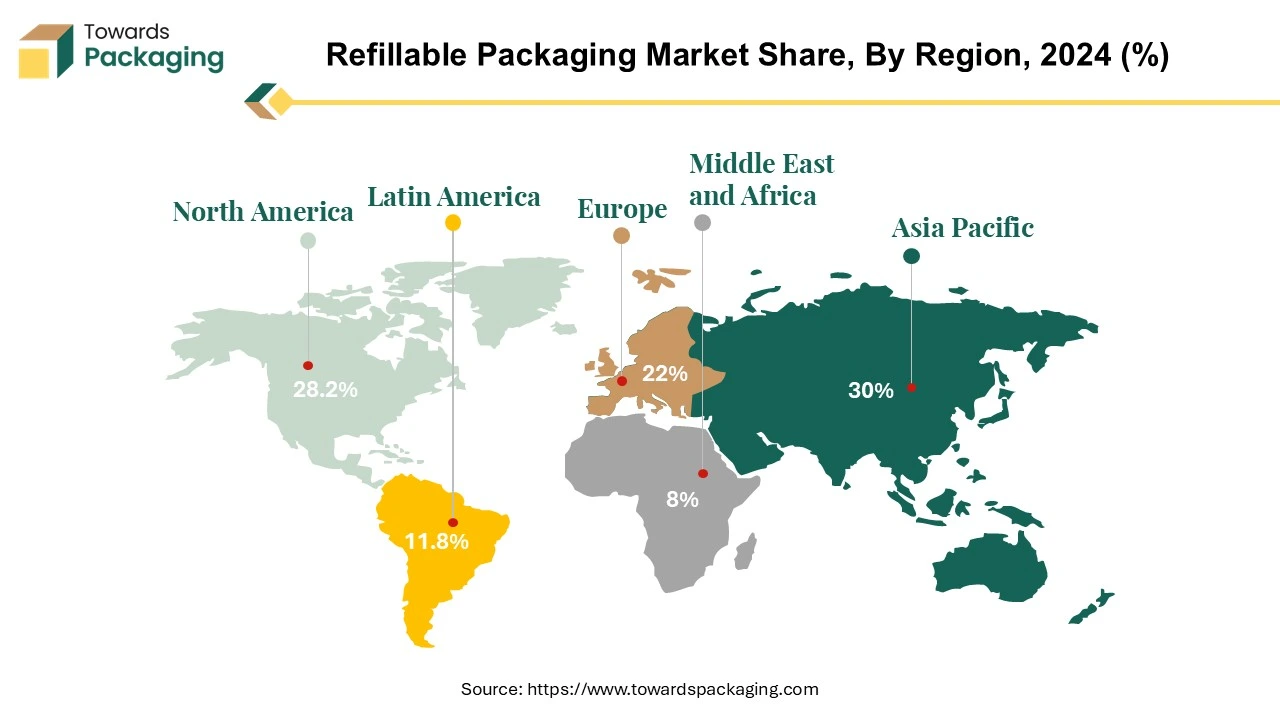
Design and Development Process
Creating user-friendly, sustainable refillable packaging demands collaboration and innovation:
- Cross-Functional Team Assembly: Bring together product developers, packaging engineers, marketing strategists, and sustainability experts to ensure all perspectives are integrated.
- Material Selection: Opt for materials that balance durability, recyclability, and align with your brand’s aesthetic values.
vUser Testing: Conduct thorough testing to confirm the refill process is intuitive, clean, and hassle-free for consumers.
- Lifecycle Assessment: Evaluate the environmental footprint of the refillable packaging compared to your traditional packaging to validate sustainability claims.
Marketing and Consumer Education
Effective communication drives consumer adoption and satisfaction:
- Clear Instructions: Provide simple, visual guides to help customers confidently use refill systems.
- Value Proposition Communication: Highlight both environmental benefits and cost savings to reinforce purchase incentives.
- In-Store Demonstrations: Equip retail staff with training to effectively demonstrate refill systems and answer customer questions.
- Loyalty Incentives: Implement reward programs that encourage repeat refill purchases and deepen brand engagement.
Measuring Success and Optimization
Continuous monitoring and refinement ensure long-term viability:
- Key Performance Indicators (KPIs): Track metrics such as refill purchase rates, customer retention, and reductions in packaging waste.
- Consumer Feedback Collection: Regularly solicit and analyze customer feedback to identify pain points or improvement areas.
- Iterative Improvement: Use data-driven insights to refine packaging design, refill processes, and marketing strategies.
- Impact Reporting: Quantify and communicate the environmental benefits achieved, reinforcing brand credibility and inspiring further customer participation.
7. Conclusion
As consumer demand for sustainable options continues to grow, particularly among younger demographics, brands that fail to explore refillable options risk being left behind. The future of beauty packaging is circular, with refillable systems playing a central role in reducing the industry’s environmental footprint while creating new opportunities for brand differentiation and consumer engagement.
For cosmetic skincare businesses looking to remain competitive in an increasingly sustainability-conscious market, now is the time to develop and implement refillable packaging strategies. By doing so, they can contribute to reducing packaging waste produced annually by the cosmetics industry while positioning themselves at the forefront of beauty’s sustainable revolution.
The path forward is clear: refillable is no longer just a trend-it’s the future of cosmetic packaging. As we move through 2025 and beyond, brands that embrace this reality today will be better positioned to thrive in the beauty landscape of tomorrow.
